University Pharmacology Report: Alcohol Consumption During Pregnancy
VerifiedAdded on 2021/04/24
|18
|5287
|232
Report
AI Summary
This pharmacology report delves into the critical issue of alcohol consumption during pregnancy, examining the ongoing debate surrounding safe alcohol levels and the potential risks to fetal development. The report synthesizes numerous studies and research findings to underscore the consensus that no amount of alcohol is definitively safe for a developing fetus. It highlights the global prevalence of alcohol use among pregnant women, citing statistics from various countries and regions, including the United States, Canada, Australia, and Africa. The report then details the adverse pregnancy consequences associated with alcohol consumption, including fetal alcohol syndrome (FAS), craniofacial malformations, cardiac anomalies, neural tube defects, and developmental and behavioral issues such as ADHD. It emphasizes the importance of complete abstinence during pregnancy and provides evidence from various studies to support the conclusion that even moderate alcohol consumption can have detrimental effects on the developing fetus, affecting its growth, development, and overall health. The report also discusses the effects of alcohol consumption on orofacial clefts, cardiac anomalies, neural tube defects, atopic dermatitis, and developmental and behavioral outcomes. The report concludes with a strong advocacy for total abstinence during pregnancy, emphasizing the potential for severe and irreversible harm caused by prenatal alcohol exposure.
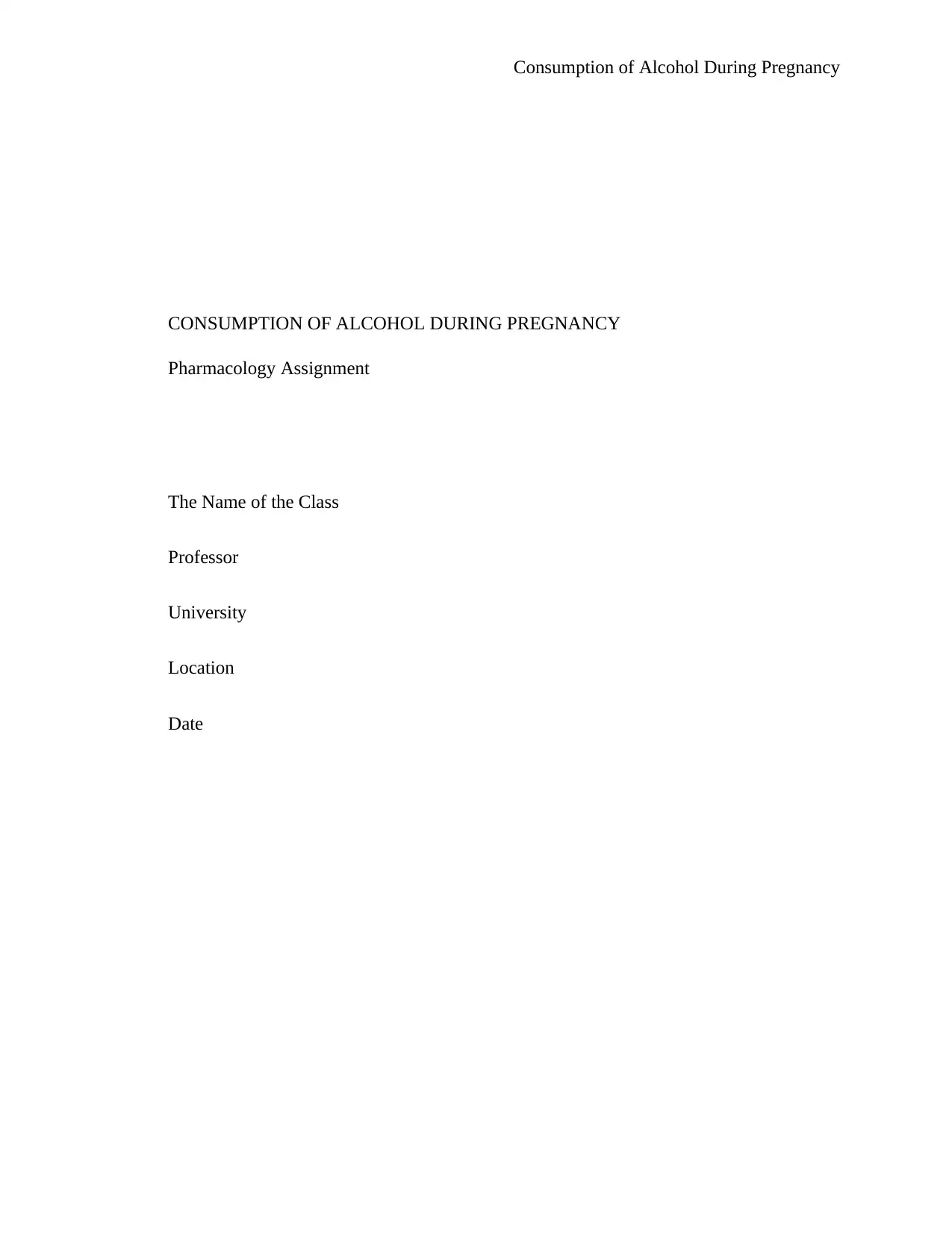
Consumption of Alcohol During Pregnancy
CONSUMPTION OF ALCOHOL DURING PREGNANCY
Pharmacology Assignment
The Name of the Class
Professor
University
Location
Date
CONSUMPTION OF ALCOHOL DURING PREGNANCY
Pharmacology Assignment
The Name of the Class
Professor
University
Location
Date
Paraphrase This Document
Need a fresh take? Get an instant paraphrase of this document with our AI Paraphraser
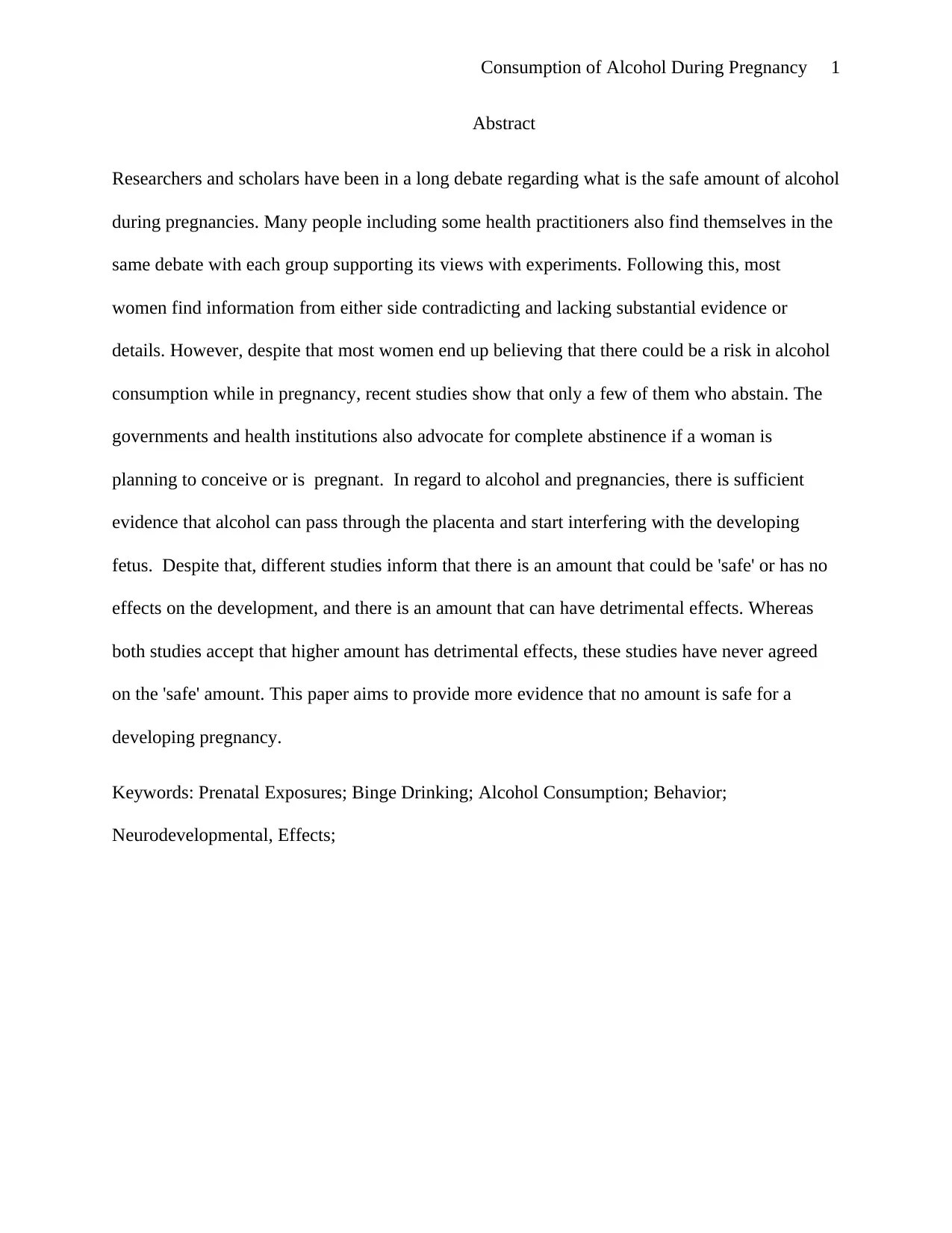
Consumption of Alcohol During Pregnancy 1
Abstract
Researchers and scholars have been in a long debate regarding what is the safe amount of alcohol
during pregnancies. Many people including some health practitioners also find themselves in the
same debate with each group supporting its views with experiments. Following this, most
women find information from either side contradicting and lacking substantial evidence or
details. However, despite that most women end up believing that there could be a risk in alcohol
consumption while in pregnancy, recent studies show that only a few of them who abstain. The
governments and health institutions also advocate for complete abstinence if a woman is
planning to conceive or is pregnant. In regard to alcohol and pregnancies, there is sufficient
evidence that alcohol can pass through the placenta and start interfering with the developing
fetus. Despite that, different studies inform that there is an amount that could be 'safe' or has no
effects on the development, and there is an amount that can have detrimental effects. Whereas
both studies accept that higher amount has detrimental effects, these studies have never agreed
on the 'safe' amount. This paper aims to provide more evidence that no amount is safe for a
developing pregnancy.
Keywords: Prenatal Exposures; Binge Drinking; Alcohol Consumption; Behavior;
Neurodevelopmental, Effects;
Abstract
Researchers and scholars have been in a long debate regarding what is the safe amount of alcohol
during pregnancies. Many people including some health practitioners also find themselves in the
same debate with each group supporting its views with experiments. Following this, most
women find information from either side contradicting and lacking substantial evidence or
details. However, despite that most women end up believing that there could be a risk in alcohol
consumption while in pregnancy, recent studies show that only a few of them who abstain. The
governments and health institutions also advocate for complete abstinence if a woman is
planning to conceive or is pregnant. In regard to alcohol and pregnancies, there is sufficient
evidence that alcohol can pass through the placenta and start interfering with the developing
fetus. Despite that, different studies inform that there is an amount that could be 'safe' or has no
effects on the development, and there is an amount that can have detrimental effects. Whereas
both studies accept that higher amount has detrimental effects, these studies have never agreed
on the 'safe' amount. This paper aims to provide more evidence that no amount is safe for a
developing pregnancy.
Keywords: Prenatal Exposures; Binge Drinking; Alcohol Consumption; Behavior;
Neurodevelopmental, Effects;
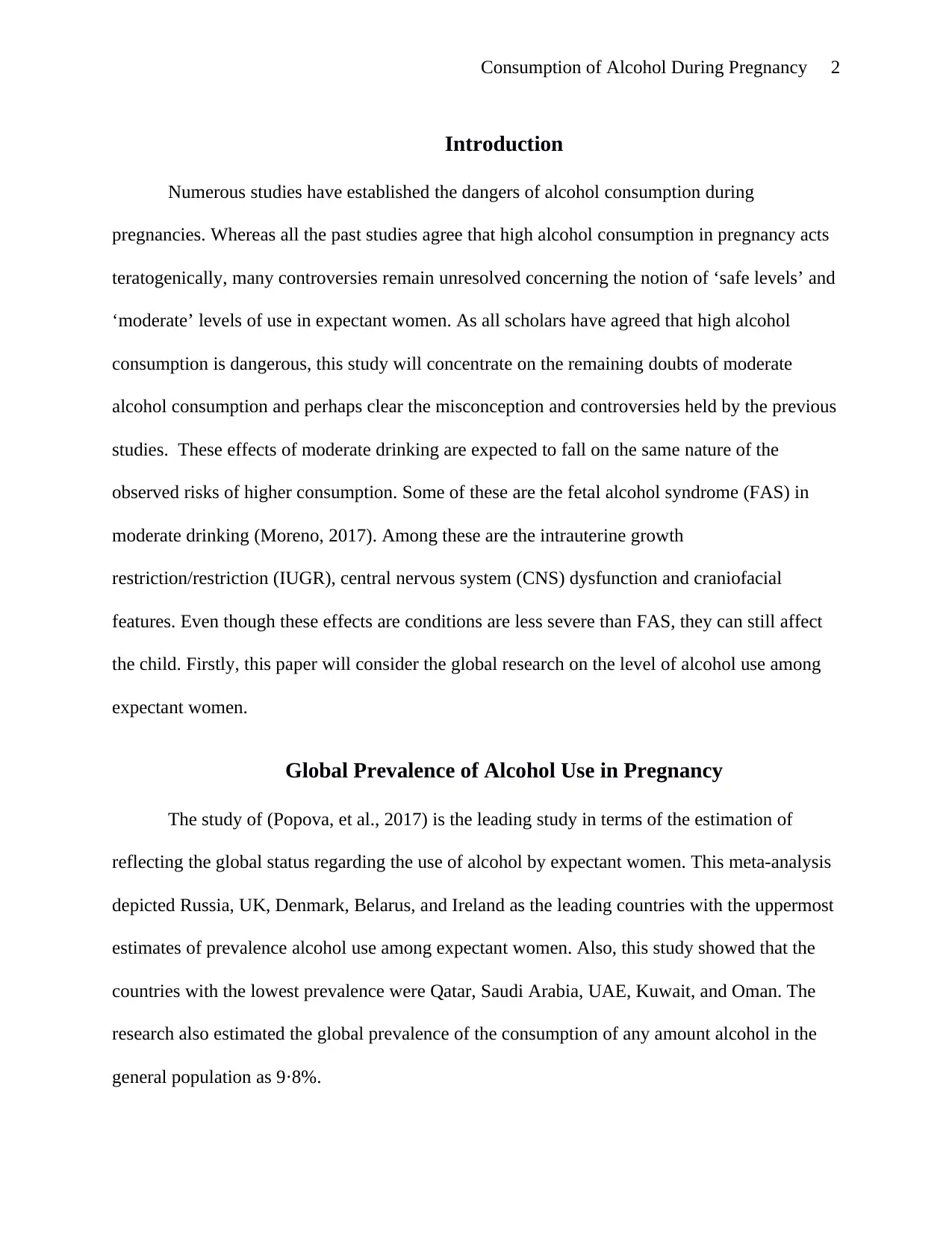
Consumption of Alcohol During Pregnancy 2
Introduction
Numerous studies have established the dangers of alcohol consumption during
pregnancies. Whereas all the past studies agree that high alcohol consumption in pregnancy acts
teratogenically, many controversies remain unresolved concerning the notion of ‘safe levels’ and
‘moderate’ levels of use in expectant women. As all scholars have agreed that high alcohol
consumption is dangerous, this study will concentrate on the remaining doubts of moderate
alcohol consumption and perhaps clear the misconception and controversies held by the previous
studies. These effects of moderate drinking are expected to fall on the same nature of the
observed risks of higher consumption. Some of these are the fetal alcohol syndrome (FAS) in
moderate drinking (Moreno, 2017). Among these are the intrauterine growth
restriction/restriction (IUGR), central nervous system (CNS) dysfunction and craniofacial
features. Even though these effects are conditions are less severe than FAS, they can still affect
the child. Firstly, this paper will consider the global research on the level of alcohol use among
expectant women.
Global Prevalence of Alcohol Use in Pregnancy
The study of (Popova, et al., 2017) is the leading study in terms of the estimation of
reflecting the global status regarding the use of alcohol by expectant women. This meta-analysis
depicted Russia, UK, Denmark, Belarus, and Ireland as the leading countries with the uppermost
estimates of prevalence alcohol use among expectant women. Also, this study showed that the
countries with the lowest prevalence were Qatar, Saudi Arabia, UAE, Kuwait, and Oman. The
research also estimated the global prevalence of the consumption of any amount alcohol in the
general population as 9·8%.
Introduction
Numerous studies have established the dangers of alcohol consumption during
pregnancies. Whereas all the past studies agree that high alcohol consumption in pregnancy acts
teratogenically, many controversies remain unresolved concerning the notion of ‘safe levels’ and
‘moderate’ levels of use in expectant women. As all scholars have agreed that high alcohol
consumption is dangerous, this study will concentrate on the remaining doubts of moderate
alcohol consumption and perhaps clear the misconception and controversies held by the previous
studies. These effects of moderate drinking are expected to fall on the same nature of the
observed risks of higher consumption. Some of these are the fetal alcohol syndrome (FAS) in
moderate drinking (Moreno, 2017). Among these are the intrauterine growth
restriction/restriction (IUGR), central nervous system (CNS) dysfunction and craniofacial
features. Even though these effects are conditions are less severe than FAS, they can still affect
the child. Firstly, this paper will consider the global research on the level of alcohol use among
expectant women.
Global Prevalence of Alcohol Use in Pregnancy
The study of (Popova, et al., 2017) is the leading study in terms of the estimation of
reflecting the global status regarding the use of alcohol by expectant women. This meta-analysis
depicted Russia, UK, Denmark, Belarus, and Ireland as the leading countries with the uppermost
estimates of prevalence alcohol use among expectant women. Also, this study showed that the
countries with the lowest prevalence were Qatar, Saudi Arabia, UAE, Kuwait, and Oman. The
research also estimated the global prevalence of the consumption of any amount alcohol in the
general population as 9·8%.
⊘ This is a preview!⊘
Do you want full access?
Subscribe today to unlock all pages.

Trusted by 1+ million students worldwide
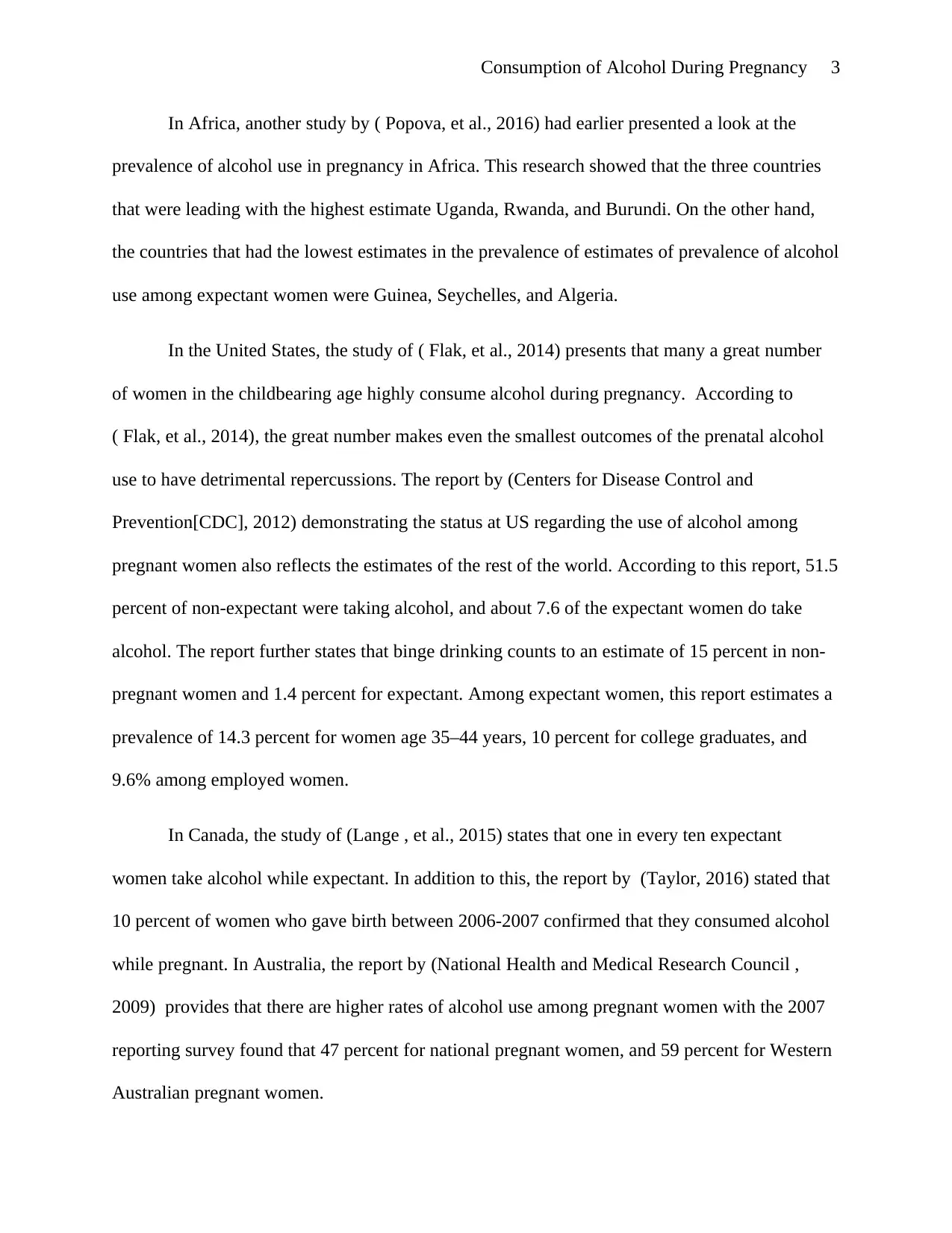
Consumption of Alcohol During Pregnancy 3
In Africa, another study by ( Popova, et al., 2016) had earlier presented a look at the
prevalence of alcohol use in pregnancy in Africa. This research showed that the three countries
that were leading with the highest estimate Uganda, Rwanda, and Burundi. On the other hand,
the countries that had the lowest estimates in the prevalence of estimates of prevalence of alcohol
use among expectant women were Guinea, Seychelles, and Algeria.
In the United States, the study of ( Flak, et al., 2014) presents that many a great number
of women in the childbearing age highly consume alcohol during pregnancy. According to
( Flak, et al., 2014), the great number makes even the smallest outcomes of the prenatal alcohol
use to have detrimental repercussions. The report by (Centers for Disease Control and
Prevention[CDC], 2012) demonstrating the status at US regarding the use of alcohol among
pregnant women also reflects the estimates of the rest of the world. According to this report, 51.5
percent of non-expectant were taking alcohol, and about 7.6 of the expectant women do take
alcohol. The report further states that binge drinking counts to an estimate of 15 percent in non-
pregnant women and 1.4 percent for expectant. Among expectant women, this report estimates a
prevalence of 14.3 percent for women age 35–44 years, 10 percent for college graduates, and
9.6% among employed women.
In Canada, the study of (Lange , et al., 2015) states that one in every ten expectant
women take alcohol while expectant. In addition to this, the report by (Taylor, 2016) stated that
10 percent of women who gave birth between 2006-2007 confirmed that they consumed alcohol
while pregnant. In Australia, the report by (National Health and Medical Research Council ,
2009) provides that there are higher rates of alcohol use among pregnant women with the 2007
reporting survey found that 47 percent for national pregnant women, and 59 percent for Western
Australian pregnant women.
In Africa, another study by ( Popova, et al., 2016) had earlier presented a look at the
prevalence of alcohol use in pregnancy in Africa. This research showed that the three countries
that were leading with the highest estimate Uganda, Rwanda, and Burundi. On the other hand,
the countries that had the lowest estimates in the prevalence of estimates of prevalence of alcohol
use among expectant women were Guinea, Seychelles, and Algeria.
In the United States, the study of ( Flak, et al., 2014) presents that many a great number
of women in the childbearing age highly consume alcohol during pregnancy. According to
( Flak, et al., 2014), the great number makes even the smallest outcomes of the prenatal alcohol
use to have detrimental repercussions. The report by (Centers for Disease Control and
Prevention[CDC], 2012) demonstrating the status at US regarding the use of alcohol among
pregnant women also reflects the estimates of the rest of the world. According to this report, 51.5
percent of non-expectant were taking alcohol, and about 7.6 of the expectant women do take
alcohol. The report further states that binge drinking counts to an estimate of 15 percent in non-
pregnant women and 1.4 percent for expectant. Among expectant women, this report estimates a
prevalence of 14.3 percent for women age 35–44 years, 10 percent for college graduates, and
9.6% among employed women.
In Canada, the study of (Lange , et al., 2015) states that one in every ten expectant
women take alcohol while expectant. In addition to this, the report by (Taylor, 2016) stated that
10 percent of women who gave birth between 2006-2007 confirmed that they consumed alcohol
while pregnant. In Australia, the report by (National Health and Medical Research Council ,
2009) provides that there are higher rates of alcohol use among pregnant women with the 2007
reporting survey found that 47 percent for national pregnant women, and 59 percent for Western
Australian pregnant women.
Paraphrase This Document
Need a fresh take? Get an instant paraphrase of this document with our AI Paraphraser
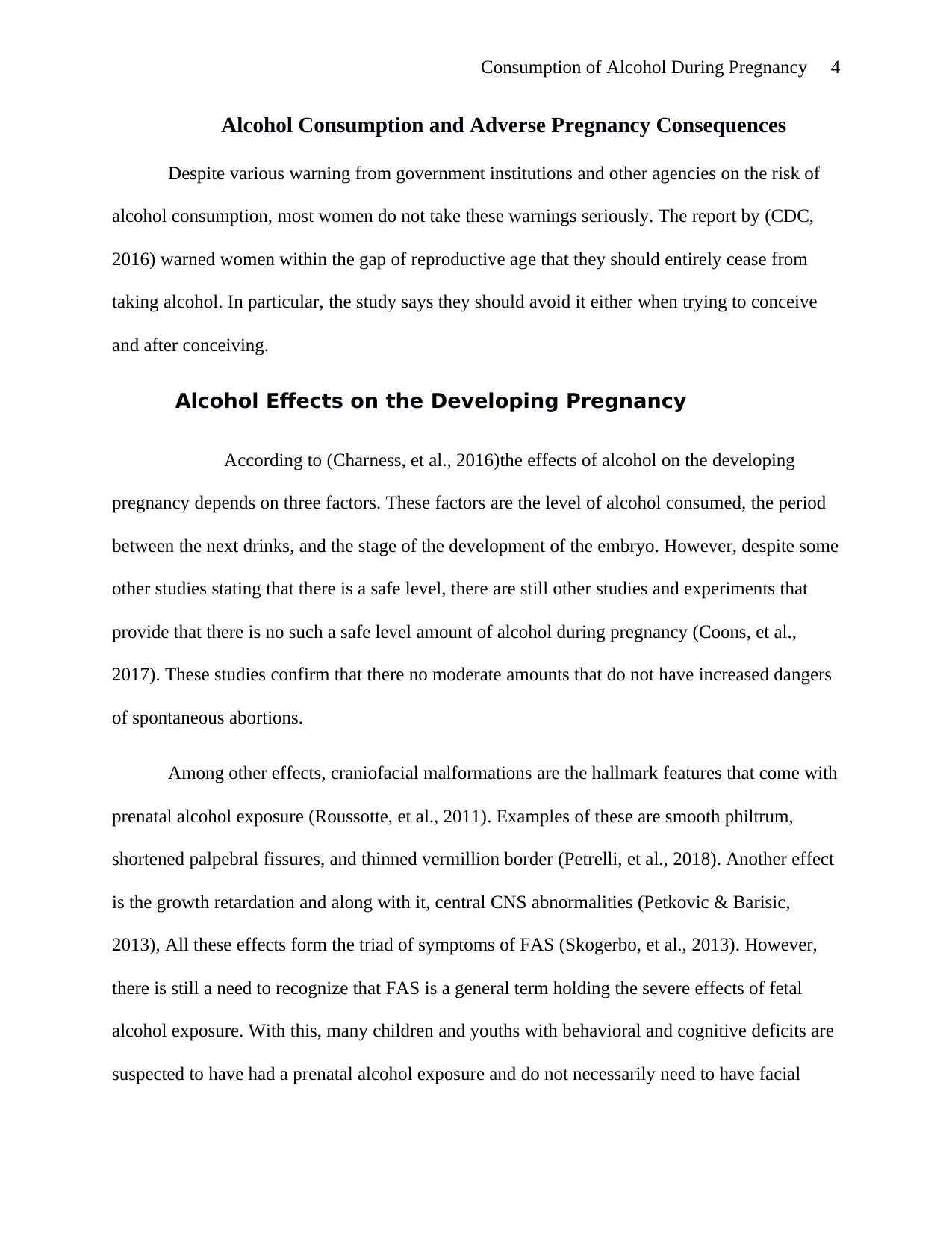
Consumption of Alcohol During Pregnancy 4
Alcohol Consumption and Adverse Pregnancy Consequences
Despite various warning from government institutions and other agencies on the risk of
alcohol consumption, most women do not take these warnings seriously. The report by (CDC,
2016) warned women within the gap of reproductive age that they should entirely cease from
taking alcohol. In particular, the study says they should avoid it either when trying to conceive
and after conceiving.
Alcohol Effects on the Developing Pregnancy
According to (Charness, et al., 2016)the effects of alcohol on the developing
pregnancy depends on three factors. These factors are the level of alcohol consumed, the period
between the next drinks, and the stage of the development of the embryo. However, despite some
other studies stating that there is a safe level, there are still other studies and experiments that
provide that there is no such a safe level amount of alcohol during pregnancy (Coons, et al.,
2017). These studies confirm that there no moderate amounts that do not have increased dangers
of spontaneous abortions.
Among other effects, craniofacial malformations are the hallmark features that come with
prenatal alcohol exposure (Roussotte, et al., 2011). Examples of these are smooth philtrum,
shortened palpebral fissures, and thinned vermillion border (Petrelli, et al., 2018). Another effect
is the growth retardation and along with it, central CNS abnormalities (Petkovic & Barisic,
2013), All these effects form the triad of symptoms of FAS (Skogerbo, et al., 2013). However,
there is still a need to recognize that FAS is a general term holding the severe effects of fetal
alcohol exposure. With this, many children and youths with behavioral and cognitive deficits are
suspected to have had a prenatal alcohol exposure and do not necessarily need to have facial
Alcohol Consumption and Adverse Pregnancy Consequences
Despite various warning from government institutions and other agencies on the risk of
alcohol consumption, most women do not take these warnings seriously. The report by (CDC,
2016) warned women within the gap of reproductive age that they should entirely cease from
taking alcohol. In particular, the study says they should avoid it either when trying to conceive
and after conceiving.
Alcohol Effects on the Developing Pregnancy
According to (Charness, et al., 2016)the effects of alcohol on the developing
pregnancy depends on three factors. These factors are the level of alcohol consumed, the period
between the next drinks, and the stage of the development of the embryo. However, despite some
other studies stating that there is a safe level, there are still other studies and experiments that
provide that there is no such a safe level amount of alcohol during pregnancy (Coons, et al.,
2017). These studies confirm that there no moderate amounts that do not have increased dangers
of spontaneous abortions.
Among other effects, craniofacial malformations are the hallmark features that come with
prenatal alcohol exposure (Roussotte, et al., 2011). Examples of these are smooth philtrum,
shortened palpebral fissures, and thinned vermillion border (Petrelli, et al., 2018). Another effect
is the growth retardation and along with it, central CNS abnormalities (Petkovic & Barisic,
2013), All these effects form the triad of symptoms of FAS (Skogerbo, et al., 2013). However,
there is still a need to recognize that FAS is a general term holding the severe effects of fetal
alcohol exposure. With this, many children and youths with behavioral and cognitive deficits are
suspected to have had a prenatal alcohol exposure and do not necessarily need to have facial
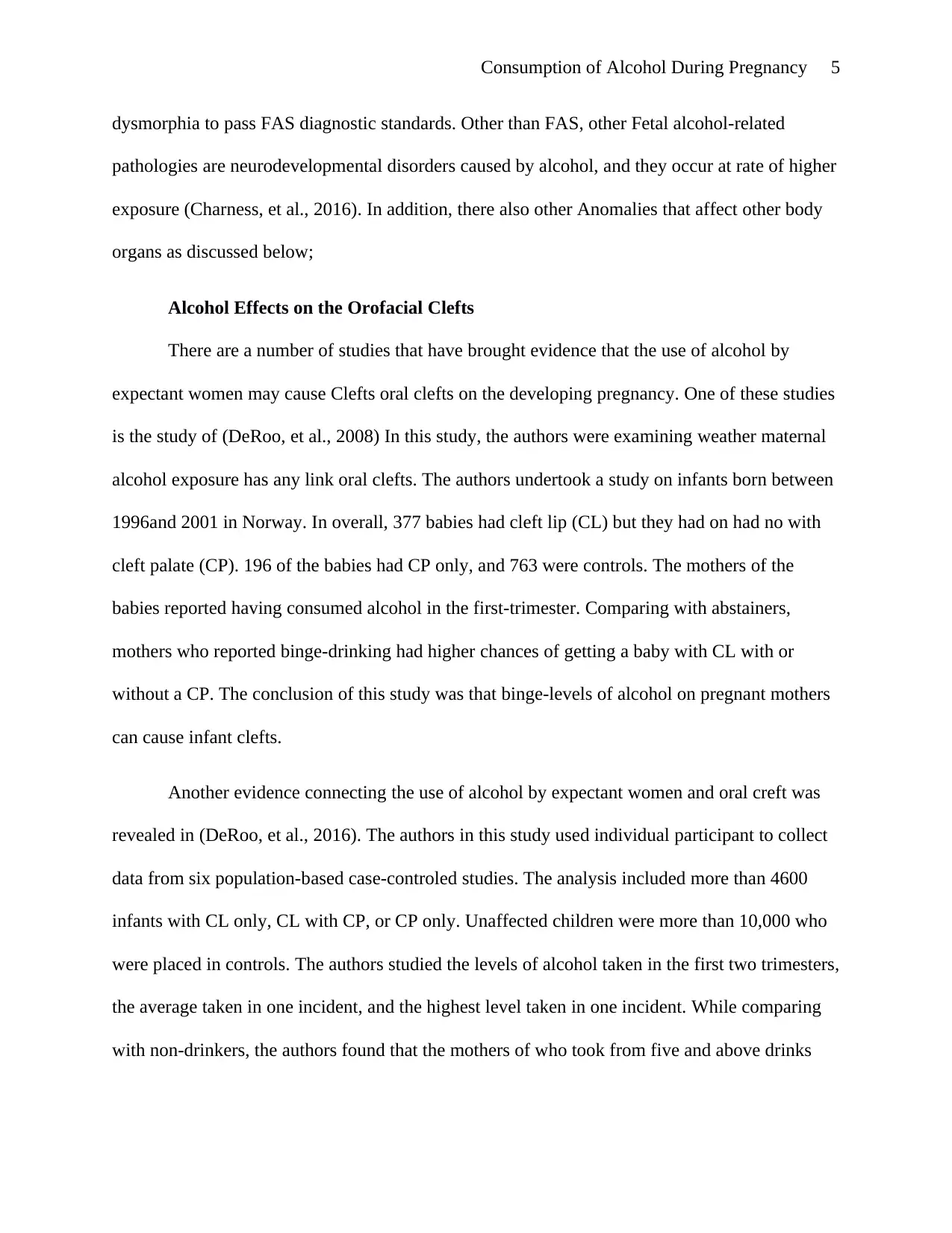
Consumption of Alcohol During Pregnancy 5
dysmorphia to pass FAS diagnostic standards. Other than FAS, other Fetal alcohol-related
pathologies are neurodevelopmental disorders caused by alcohol, and they occur at rate of higher
exposure (Charness, et al., 2016). In addition, there also other Anomalies that affect other body
organs as discussed below;
Alcohol Effects on the Orofacial Clefts
There are a number of studies that have brought evidence that the use of alcohol by
expectant women may cause Clefts oral clefts on the developing pregnancy. One of these studies
is the study of (DeRoo, et al., 2008) In this study, the authors were examining weather maternal
alcohol exposure has any link oral clefts. The authors undertook a study on infants born between
1996and 2001 in Norway. In overall, 377 babies had cleft lip (CL) but they had on had no with
cleft palate (CP). 196 of the babies had CP only, and 763 were controls. The mothers of the
babies reported having consumed alcohol in the first-trimester. Comparing with abstainers,
mothers who reported binge-drinking had higher chances of getting a baby with CL with or
without a CP. The conclusion of this study was that binge-levels of alcohol on pregnant mothers
can cause infant clefts.
Another evidence connecting the use of alcohol by expectant women and oral creft was
revealed in (DeRoo, et al., 2016). The authors in this study used individual participant to collect
data from six population-based case-controled studies. The analysis included more than 4600
infants with CL only, CL with CP, or CP only. Unaffected children were more than 10,000 who
were placed in controls. The authors studied the levels of alcohol taken in the first two trimesters,
the average taken in one incident, and the highest level taken in one incident. While comparing
with non-drinkers, the authors found that the mothers of who took from five and above drinks
dysmorphia to pass FAS diagnostic standards. Other than FAS, other Fetal alcohol-related
pathologies are neurodevelopmental disorders caused by alcohol, and they occur at rate of higher
exposure (Charness, et al., 2016). In addition, there also other Anomalies that affect other body
organs as discussed below;
Alcohol Effects on the Orofacial Clefts
There are a number of studies that have brought evidence that the use of alcohol by
expectant women may cause Clefts oral clefts on the developing pregnancy. One of these studies
is the study of (DeRoo, et al., 2008) In this study, the authors were examining weather maternal
alcohol exposure has any link oral clefts. The authors undertook a study on infants born between
1996and 2001 in Norway. In overall, 377 babies had cleft lip (CL) but they had on had no with
cleft palate (CP). 196 of the babies had CP only, and 763 were controls. The mothers of the
babies reported having consumed alcohol in the first-trimester. Comparing with abstainers,
mothers who reported binge-drinking had higher chances of getting a baby with CL with or
without a CP. The conclusion of this study was that binge-levels of alcohol on pregnant mothers
can cause infant clefts.
Another evidence connecting the use of alcohol by expectant women and oral creft was
revealed in (DeRoo, et al., 2016). The authors in this study used individual participant to collect
data from six population-based case-controled studies. The analysis included more than 4600
infants with CL only, CL with CP, or CP only. Unaffected children were more than 10,000 who
were placed in controls. The authors studied the levels of alcohol taken in the first two trimesters,
the average taken in one incident, and the highest level taken in one incident. While comparing
with non-drinkers, the authors found that the mothers of who took from five and above drinks
⊘ This is a preview!⊘
Do you want full access?
Subscribe today to unlock all pages.

Trusted by 1+ million students worldwide
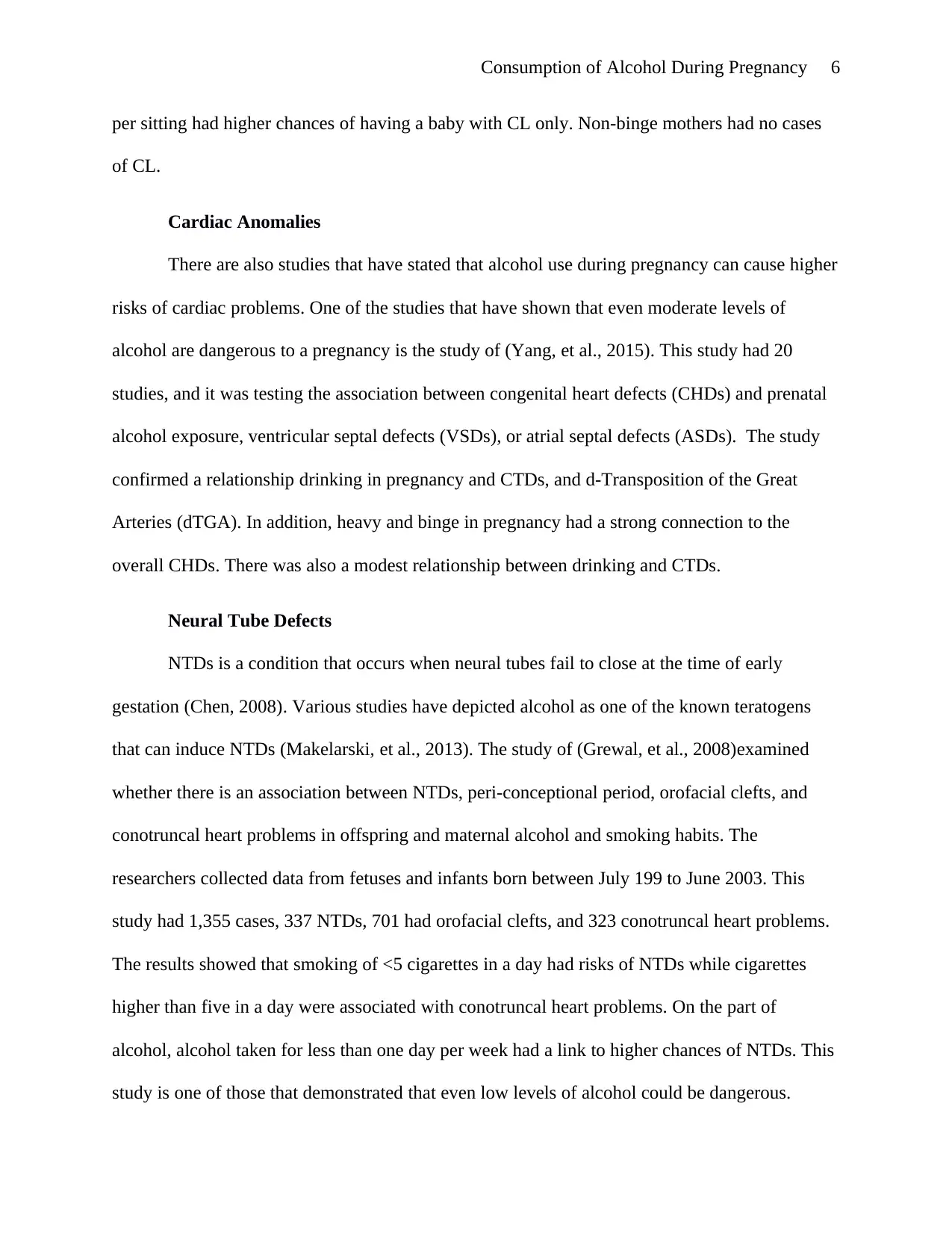
Consumption of Alcohol During Pregnancy 6
per sitting had higher chances of having a baby with CL only. Non-binge mothers had no cases
of CL.
Cardiac Anomalies
There are also studies that have stated that alcohol use during pregnancy can cause higher
risks of cardiac problems. One of the studies that have shown that even moderate levels of
alcohol are dangerous to a pregnancy is the study of (Yang, et al., 2015). This study had 20
studies, and it was testing the association between congenital heart defects (CHDs) and prenatal
alcohol exposure, ventricular septal defects (VSDs), or atrial septal defects (ASDs). The study
confirmed a relationship drinking in pregnancy and CTDs, and d-Transposition of the Great
Arteries (dTGA). In addition, heavy and binge in pregnancy had a strong connection to the
overall CHDs. There was also a modest relationship between drinking and CTDs.
Neural Tube Defects
NTDs is a condition that occurs when neural tubes fail to close at the time of early
gestation (Chen, 2008). Various studies have depicted alcohol as one of the known teratogens
that can induce NTDs (Makelarski, et al., 2013). The study of (Grewal, et al., 2008)examined
whether there is an association between NTDs, peri-conceptional period, orofacial clefts, and
conotruncal heart problems in offspring and maternal alcohol and smoking habits. The
researchers collected data from fetuses and infants born between July 199 to June 2003. This
study had 1,355 cases, 337 NTDs, 701 had orofacial clefts, and 323 conotruncal heart problems.
The results showed that smoking of <5 cigarettes in a day had risks of NTDs while cigarettes
higher than five in a day were associated with conotruncal heart problems. On the part of
alcohol, alcohol taken for less than one day per week had a link to higher chances of NTDs. This
study is one of those that demonstrated that even low levels of alcohol could be dangerous.
per sitting had higher chances of having a baby with CL only. Non-binge mothers had no cases
of CL.
Cardiac Anomalies
There are also studies that have stated that alcohol use during pregnancy can cause higher
risks of cardiac problems. One of the studies that have shown that even moderate levels of
alcohol are dangerous to a pregnancy is the study of (Yang, et al., 2015). This study had 20
studies, and it was testing the association between congenital heart defects (CHDs) and prenatal
alcohol exposure, ventricular septal defects (VSDs), or atrial septal defects (ASDs). The study
confirmed a relationship drinking in pregnancy and CTDs, and d-Transposition of the Great
Arteries (dTGA). In addition, heavy and binge in pregnancy had a strong connection to the
overall CHDs. There was also a modest relationship between drinking and CTDs.
Neural Tube Defects
NTDs is a condition that occurs when neural tubes fail to close at the time of early
gestation (Chen, 2008). Various studies have depicted alcohol as one of the known teratogens
that can induce NTDs (Makelarski, et al., 2013). The study of (Grewal, et al., 2008)examined
whether there is an association between NTDs, peri-conceptional period, orofacial clefts, and
conotruncal heart problems in offspring and maternal alcohol and smoking habits. The
researchers collected data from fetuses and infants born between July 199 to June 2003. This
study had 1,355 cases, 337 NTDs, 701 had orofacial clefts, and 323 conotruncal heart problems.
The results showed that smoking of <5 cigarettes in a day had risks of NTDs while cigarettes
higher than five in a day were associated with conotruncal heart problems. On the part of
alcohol, alcohol taken for less than one day per week had a link to higher chances of NTDs. This
study is one of those that demonstrated that even low levels of alcohol could be dangerous.
Paraphrase This Document
Need a fresh take? Get an instant paraphrase of this document with our AI Paraphraser
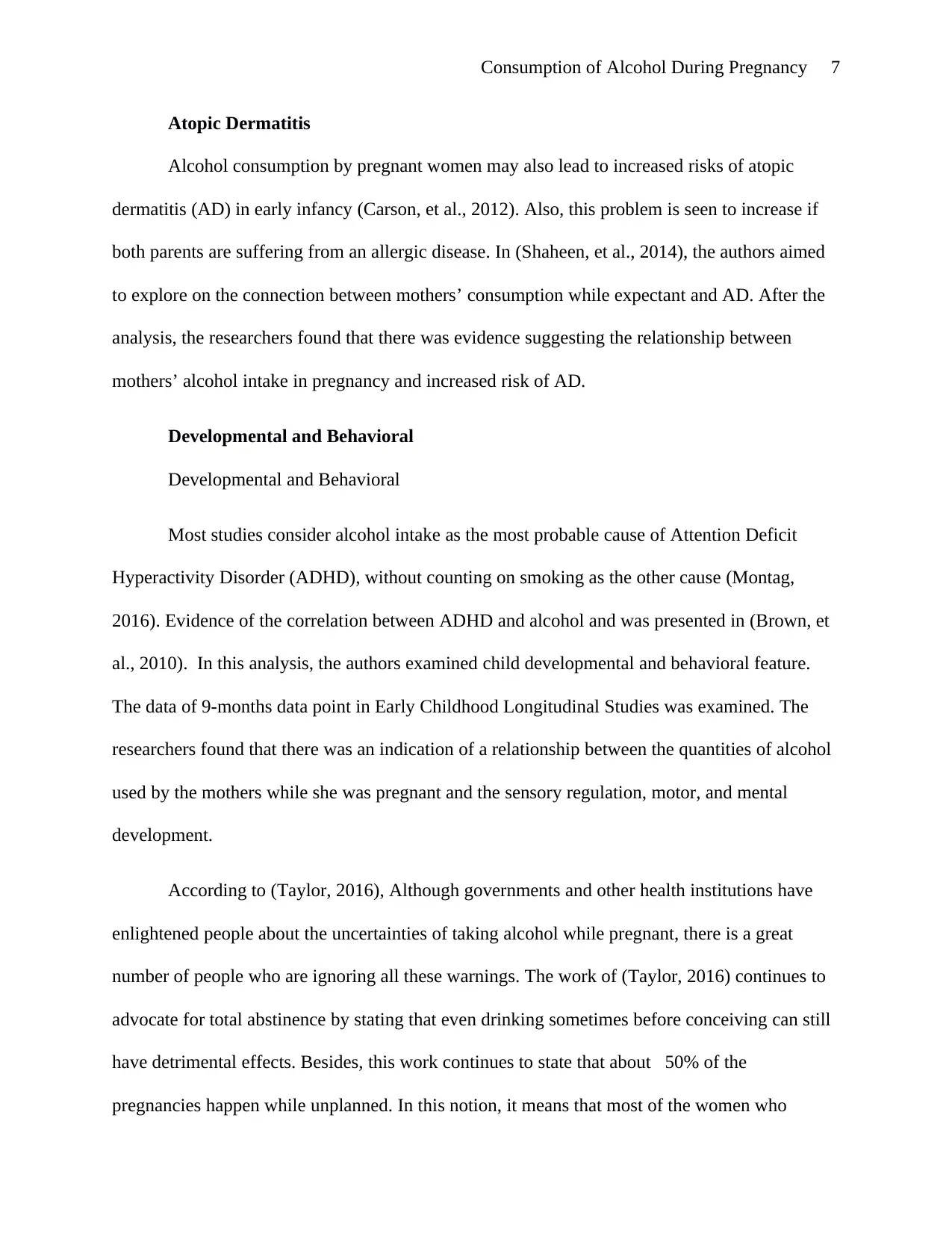
Consumption of Alcohol During Pregnancy 7
Atopic Dermatitis
Alcohol consumption by pregnant women may also lead to increased risks of atopic
dermatitis (AD) in early infancy (Carson, et al., 2012). Also, this problem is seen to increase if
both parents are suffering from an allergic disease. In (Shaheen, et al., 2014), the authors aimed
to explore on the connection between mothers’ consumption while expectant and AD. After the
analysis, the researchers found that there was evidence suggesting the relationship between
mothers’ alcohol intake in pregnancy and increased risk of AD.
Developmental and Behavioral
Developmental and Behavioral
Most studies consider alcohol intake as the most probable cause of Attention Deficit
Hyperactivity Disorder (ADHD), without counting on smoking as the other cause (Montag,
2016). Evidence of the correlation between ADHD and alcohol and was presented in (Brown, et
al., 2010). In this analysis, the authors examined child developmental and behavioral feature.
The data of 9-months data point in Early Childhood Longitudinal Studies was examined. The
researchers found that there was an indication of a relationship between the quantities of alcohol
used by the mothers while she was pregnant and the sensory regulation, motor, and mental
development.
According to (Taylor, 2016), Although governments and other health institutions have
enlightened people about the uncertainties of taking alcohol while pregnant, there is a great
number of people who are ignoring all these warnings. The work of (Taylor, 2016) continues to
advocate for total abstinence by stating that even drinking sometimes before conceiving can still
have detrimental effects. Besides, this work continues to state that about 50% of the
pregnancies happen while unplanned. In this notion, it means that most of the women who
Atopic Dermatitis
Alcohol consumption by pregnant women may also lead to increased risks of atopic
dermatitis (AD) in early infancy (Carson, et al., 2012). Also, this problem is seen to increase if
both parents are suffering from an allergic disease. In (Shaheen, et al., 2014), the authors aimed
to explore on the connection between mothers’ consumption while expectant and AD. After the
analysis, the researchers found that there was evidence suggesting the relationship between
mothers’ alcohol intake in pregnancy and increased risk of AD.
Developmental and Behavioral
Developmental and Behavioral
Most studies consider alcohol intake as the most probable cause of Attention Deficit
Hyperactivity Disorder (ADHD), without counting on smoking as the other cause (Montag,
2016). Evidence of the correlation between ADHD and alcohol and was presented in (Brown, et
al., 2010). In this analysis, the authors examined child developmental and behavioral feature.
The data of 9-months data point in Early Childhood Longitudinal Studies was examined. The
researchers found that there was an indication of a relationship between the quantities of alcohol
used by the mothers while she was pregnant and the sensory regulation, motor, and mental
development.
According to (Taylor, 2016), Although governments and other health institutions have
enlightened people about the uncertainties of taking alcohol while pregnant, there is a great
number of people who are ignoring all these warnings. The work of (Taylor, 2016) continues to
advocate for total abstinence by stating that even drinking sometimes before conceiving can still
have detrimental effects. Besides, this work continues to state that about 50% of the
pregnancies happen while unplanned. In this notion, it means that most of the women who
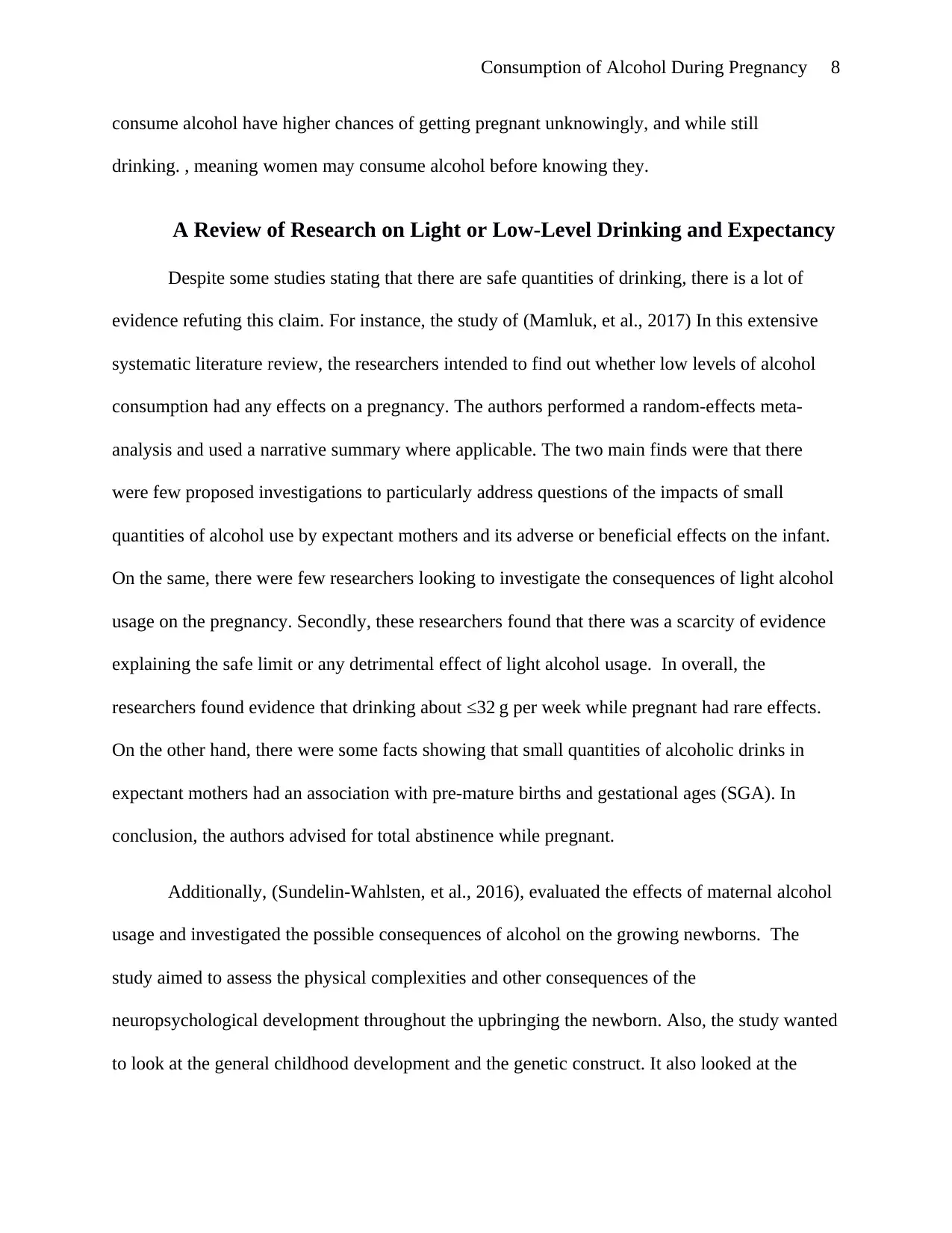
Consumption of Alcohol During Pregnancy 8
consume alcohol have higher chances of getting pregnant unknowingly, and while still
drinking. , meaning women may consume alcohol before knowing they.
A Review of Research on Light or Low-Level Drinking and Expectancy
Despite some studies stating that there are safe quantities of drinking, there is a lot of
evidence refuting this claim. For instance, the study of (Mamluk, et al., 2017) In this extensive
systematic literature review, the researchers intended to find out whether low levels of alcohol
consumption had any effects on a pregnancy. The authors performed a random-effects meta-
analysis and used a narrative summary where applicable. The two main finds were that there
were few proposed investigations to particularly address questions of the impacts of small
quantities of alcohol use by expectant mothers and its adverse or beneficial effects on the infant.
On the same, there were few researchers looking to investigate the consequences of light alcohol
usage on the pregnancy. Secondly, these researchers found that there was a scarcity of evidence
explaining the safe limit or any detrimental effect of light alcohol usage. In overall, the
researchers found evidence that drinking about ≤32 g per week while pregnant had rare effects.
On the other hand, there were some facts showing that small quantities of alcoholic drinks in
expectant mothers had an association with pre-mature births and gestational ages (SGA). In
conclusion, the authors advised for total abstinence while pregnant.
Additionally, (Sundelin-Wahlsten, et al., 2016), evaluated the effects of maternal alcohol
usage and investigated the possible consequences of alcohol on the growing newborns. The
study aimed to assess the physical complexities and other consequences of the
neuropsychological development throughout the upbringing the newborn. Also, the study wanted
to look at the general childhood development and the genetic construct. It also looked at the
consume alcohol have higher chances of getting pregnant unknowingly, and while still
drinking. , meaning women may consume alcohol before knowing they.
A Review of Research on Light or Low-Level Drinking and Expectancy
Despite some studies stating that there are safe quantities of drinking, there is a lot of
evidence refuting this claim. For instance, the study of (Mamluk, et al., 2017) In this extensive
systematic literature review, the researchers intended to find out whether low levels of alcohol
consumption had any effects on a pregnancy. The authors performed a random-effects meta-
analysis and used a narrative summary where applicable. The two main finds were that there
were few proposed investigations to particularly address questions of the impacts of small
quantities of alcohol use by expectant mothers and its adverse or beneficial effects on the infant.
On the same, there were few researchers looking to investigate the consequences of light alcohol
usage on the pregnancy. Secondly, these researchers found that there was a scarcity of evidence
explaining the safe limit or any detrimental effect of light alcohol usage. In overall, the
researchers found evidence that drinking about ≤32 g per week while pregnant had rare effects.
On the other hand, there were some facts showing that small quantities of alcoholic drinks in
expectant mothers had an association with pre-mature births and gestational ages (SGA). In
conclusion, the authors advised for total abstinence while pregnant.
Additionally, (Sundelin-Wahlsten, et al., 2016), evaluated the effects of maternal alcohol
usage and investigated the possible consequences of alcohol on the growing newborns. The
study aimed to assess the physical complexities and other consequences of the
neuropsychological development throughout the upbringing the newborn. Also, the study wanted
to look at the general childhood development and the genetic construct. It also looked at the
⊘ This is a preview!⊘
Do you want full access?
Subscribe today to unlock all pages.

Trusted by 1+ million students worldwide
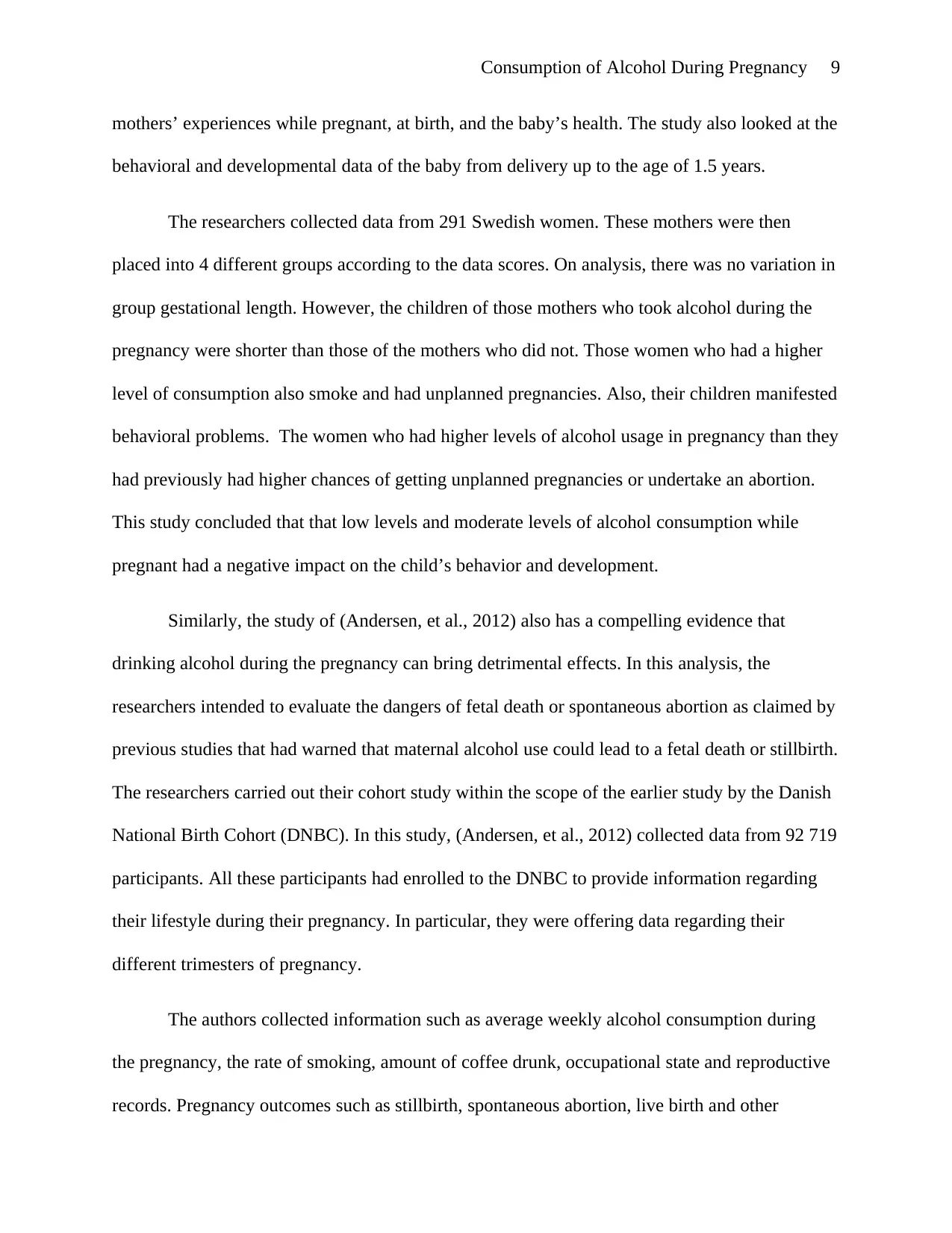
Consumption of Alcohol During Pregnancy 9
mothers’ experiences while pregnant, at birth, and the baby’s health. The study also looked at the
behavioral and developmental data of the baby from delivery up to the age of 1.5 years.
The researchers collected data from 291 Swedish women. These mothers were then
placed into 4 different groups according to the data scores. On analysis, there was no variation in
group gestational length. However, the children of those mothers who took alcohol during the
pregnancy were shorter than those of the mothers who did not. Those women who had a higher
level of consumption also smoke and had unplanned pregnancies. Also, their children manifested
behavioral problems. The women who had higher levels of alcohol usage in pregnancy than they
had previously had higher chances of getting unplanned pregnancies or undertake an abortion.
This study concluded that that low levels and moderate levels of alcohol consumption while
pregnant had a negative impact on the child’s behavior and development.
Similarly, the study of (Andersen, et al., 2012) also has a compelling evidence that
drinking alcohol during the pregnancy can bring detrimental effects. In this analysis, the
researchers intended to evaluate the dangers of fetal death or spontaneous abortion as claimed by
previous studies that had warned that maternal alcohol use could lead to a fetal death or stillbirth.
The researchers carried out their cohort study within the scope of the earlier study by the Danish
National Birth Cohort (DNBC). In this study, (Andersen, et al., 2012) collected data from 92 719
participants. All these participants had enrolled to the DNBC to provide information regarding
their lifestyle during their pregnancy. In particular, they were offering data regarding their
different trimesters of pregnancy.
The authors collected information such as average weekly alcohol consumption during
the pregnancy, the rate of smoking, amount of coffee drunk, occupational state and reproductive
records. Pregnancy outcomes such as stillbirth, spontaneous abortion, live birth and other
mothers’ experiences while pregnant, at birth, and the baby’s health. The study also looked at the
behavioral and developmental data of the baby from delivery up to the age of 1.5 years.
The researchers collected data from 291 Swedish women. These mothers were then
placed into 4 different groups according to the data scores. On analysis, there was no variation in
group gestational length. However, the children of those mothers who took alcohol during the
pregnancy were shorter than those of the mothers who did not. Those women who had a higher
level of consumption also smoke and had unplanned pregnancies. Also, their children manifested
behavioral problems. The women who had higher levels of alcohol usage in pregnancy than they
had previously had higher chances of getting unplanned pregnancies or undertake an abortion.
This study concluded that that low levels and moderate levels of alcohol consumption while
pregnant had a negative impact on the child’s behavior and development.
Similarly, the study of (Andersen, et al., 2012) also has a compelling evidence that
drinking alcohol during the pregnancy can bring detrimental effects. In this analysis, the
researchers intended to evaluate the dangers of fetal death or spontaneous abortion as claimed by
previous studies that had warned that maternal alcohol use could lead to a fetal death or stillbirth.
The researchers carried out their cohort study within the scope of the earlier study by the Danish
National Birth Cohort (DNBC). In this study, (Andersen, et al., 2012) collected data from 92 719
participants. All these participants had enrolled to the DNBC to provide information regarding
their lifestyle during their pregnancy. In particular, they were offering data regarding their
different trimesters of pregnancy.
The authors collected information such as average weekly alcohol consumption during
the pregnancy, the rate of smoking, amount of coffee drunk, occupational state and reproductive
records. Pregnancy outcomes such as stillbirth, spontaneous abortion, live birth and other
Paraphrase This Document
Need a fresh take? Get an instant paraphrase of this document with our AI Paraphraser
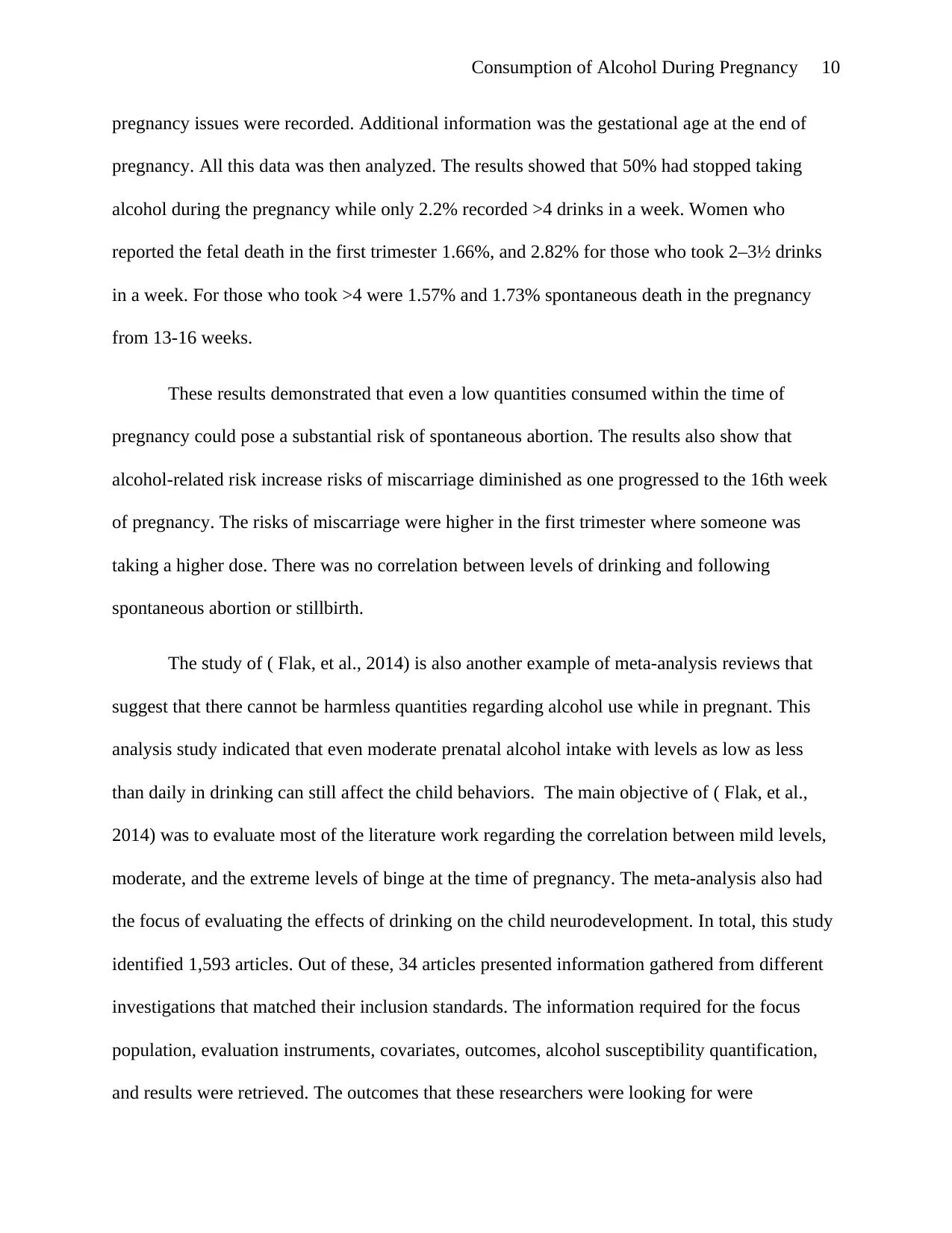
Consumption of Alcohol During Pregnancy 10
pregnancy issues were recorded. Additional information was the gestational age at the end of
pregnancy. All this data was then analyzed. The results showed that 50% had stopped taking
alcohol during the pregnancy while only 2.2% recorded >4 drinks in a week. Women who
reported the fetal death in the first trimester 1.66%, and 2.82% for those who took 2–3½ drinks
in a week. For those who took >4 were 1.57% and 1.73% spontaneous death in the pregnancy
from 13-16 weeks.
These results demonstrated that even a low quantities consumed within the time of
pregnancy could pose a substantial risk of spontaneous abortion. The results also show that
alcohol-related risk increase risks of miscarriage diminished as one progressed to the 16th week
of pregnancy. The risks of miscarriage were higher in the first trimester where someone was
taking a higher dose. There was no correlation between levels of drinking and following
spontaneous abortion or stillbirth.
The study of ( Flak, et al., 2014) is also another example of meta-analysis reviews that
suggest that there cannot be harmless quantities regarding alcohol use while in pregnant. This
analysis study indicated that even moderate prenatal alcohol intake with levels as low as less
than daily in drinking can still affect the child behaviors. The main objective of ( Flak, et al.,
2014) was to evaluate most of the literature work regarding the correlation between mild levels,
moderate, and the extreme levels of binge at the time of pregnancy. The meta-analysis also had
the focus of evaluating the effects of drinking on the child neurodevelopment. In total, this study
identified 1,593 articles. Out of these, 34 articles presented information gathered from different
investigations that matched their inclusion standards. The information required for the focus
population, evaluation instruments, covariates, outcomes, alcohol susceptibility quantification,
and results were retrieved. The outcomes that these researchers were looking for were
pregnancy issues were recorded. Additional information was the gestational age at the end of
pregnancy. All this data was then analyzed. The results showed that 50% had stopped taking
alcohol during the pregnancy while only 2.2% recorded >4 drinks in a week. Women who
reported the fetal death in the first trimester 1.66%, and 2.82% for those who took 2–3½ drinks
in a week. For those who took >4 were 1.57% and 1.73% spontaneous death in the pregnancy
from 13-16 weeks.
These results demonstrated that even a low quantities consumed within the time of
pregnancy could pose a substantial risk of spontaneous abortion. The results also show that
alcohol-related risk increase risks of miscarriage diminished as one progressed to the 16th week
of pregnancy. The risks of miscarriage were higher in the first trimester where someone was
taking a higher dose. There was no correlation between levels of drinking and following
spontaneous abortion or stillbirth.
The study of ( Flak, et al., 2014) is also another example of meta-analysis reviews that
suggest that there cannot be harmless quantities regarding alcohol use while in pregnant. This
analysis study indicated that even moderate prenatal alcohol intake with levels as low as less
than daily in drinking can still affect the child behaviors. The main objective of ( Flak, et al.,
2014) was to evaluate most of the literature work regarding the correlation between mild levels,
moderate, and the extreme levels of binge at the time of pregnancy. The meta-analysis also had
the focus of evaluating the effects of drinking on the child neurodevelopment. In total, this study
identified 1,593 articles. Out of these, 34 articles presented information gathered from different
investigations that matched their inclusion standards. The information required for the focus
population, evaluation instruments, covariates, outcomes, alcohol susceptibility quantification,
and results were retrieved. The outcomes that these researchers were looking for were
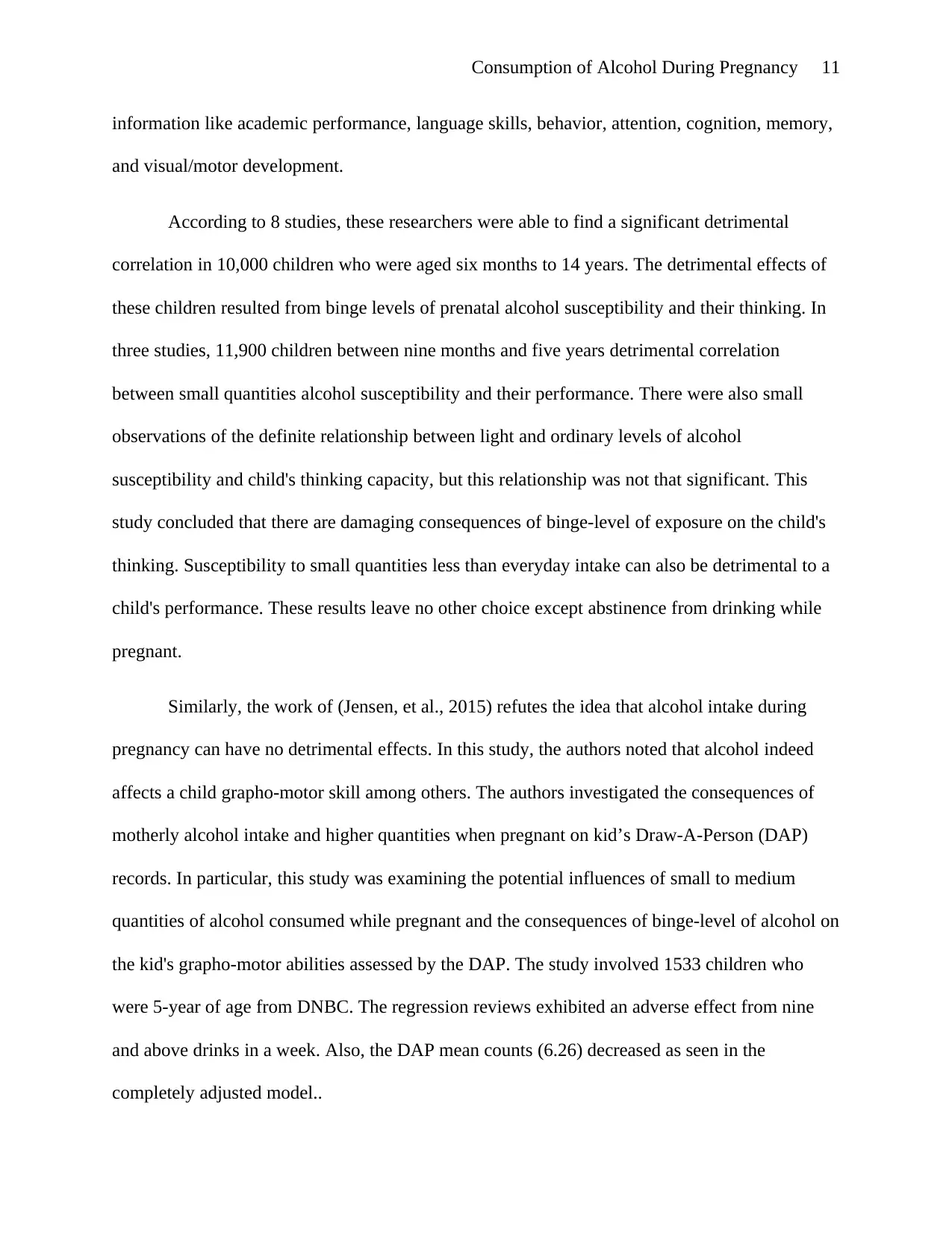
Consumption of Alcohol During Pregnancy 11
information like academic performance, language skills, behavior, attention, cognition, memory,
and visual/motor development.
According to 8 studies, these researchers were able to find a significant detrimental
correlation in 10,000 children who were aged six months to 14 years. The detrimental effects of
these children resulted from binge levels of prenatal alcohol susceptibility and their thinking. In
three studies, 11,900 children between nine months and five years detrimental correlation
between small quantities alcohol susceptibility and their performance. There were also small
observations of the definite relationship between light and ordinary levels of alcohol
susceptibility and child's thinking capacity, but this relationship was not that significant. This
study concluded that there are damaging consequences of binge-level of exposure on the child's
thinking. Susceptibility to small quantities less than everyday intake can also be detrimental to a
child's performance. These results leave no other choice except abstinence from drinking while
pregnant.
Similarly, the work of (Jensen, et al., 2015) refutes the idea that alcohol intake during
pregnancy can have no detrimental effects. In this study, the authors noted that alcohol indeed
affects a child grapho-motor skill among others. The authors investigated the consequences of
motherly alcohol intake and higher quantities when pregnant on kid’s Draw-A-Person (DAP)
records. In particular, this study was examining the potential influences of small to medium
quantities of alcohol consumed while pregnant and the consequences of binge-level of alcohol on
the kid's grapho-motor abilities assessed by the DAP. The study involved 1533 children who
were 5-year of age from DNBC. The regression reviews exhibited an adverse effect from nine
and above drinks in a week. Also, the DAP mean counts (6.26) decreased as seen in the
completely adjusted model..
information like academic performance, language skills, behavior, attention, cognition, memory,
and visual/motor development.
According to 8 studies, these researchers were able to find a significant detrimental
correlation in 10,000 children who were aged six months to 14 years. The detrimental effects of
these children resulted from binge levels of prenatal alcohol susceptibility and their thinking. In
three studies, 11,900 children between nine months and five years detrimental correlation
between small quantities alcohol susceptibility and their performance. There were also small
observations of the definite relationship between light and ordinary levels of alcohol
susceptibility and child's thinking capacity, but this relationship was not that significant. This
study concluded that there are damaging consequences of binge-level of exposure on the child's
thinking. Susceptibility to small quantities less than everyday intake can also be detrimental to a
child's performance. These results leave no other choice except abstinence from drinking while
pregnant.
Similarly, the work of (Jensen, et al., 2015) refutes the idea that alcohol intake during
pregnancy can have no detrimental effects. In this study, the authors noted that alcohol indeed
affects a child grapho-motor skill among others. The authors investigated the consequences of
motherly alcohol intake and higher quantities when pregnant on kid’s Draw-A-Person (DAP)
records. In particular, this study was examining the potential influences of small to medium
quantities of alcohol consumed while pregnant and the consequences of binge-level of alcohol on
the kid's grapho-motor abilities assessed by the DAP. The study involved 1533 children who
were 5-year of age from DNBC. The regression reviews exhibited an adverse effect from nine
and above drinks in a week. Also, the DAP mean counts (6.26) decreased as seen in the
completely adjusted model..
⊘ This is a preview!⊘
Do you want full access?
Subscribe today to unlock all pages.

Trusted by 1+ million students worldwide
1 out of 18
Related Documents
Your All-in-One AI-Powered Toolkit for Academic Success.
+13062052269
info@desklib.com
Available 24*7 on WhatsApp / Email
![[object Object]](/_next/static/media/star-bottom.7253800d.svg)
Unlock your academic potential
Copyright © 2020–2025 A2Z Services. All Rights Reserved. Developed and managed by ZUCOL.




